 | ||
The costume of the Ku Klux Klan (sometimes known as the "glory suit" by Klansmen) is perhaps the most distinctive feature of the Ku Klux Klan, and is recognized worldwide. The archetypal outfit was actually popularized largely during the revival of the Klan from 1915 to 1944 and consists of: a floor-length, solid-white robe (often decorated with a round badge bearing an insignia with a cross) and a white, sharply pointed hat that includes a full-faced cloth mask with eyeholes. The basic costume, which has some rank-based and regional variations, is designed deliberately both to disguise its wearer's identity and to give the wearer an intimidating appearance.
Contents
Development
The origins of the use of the costume are unclear. Such garments have been traditionally used at least from the 15th century in festivities such as Holy Week, symbolizing the act of penance. In Spain and its former territories, which included parts of the United States, the pointed hat is called "capirote". It is unrelated to the KKK except by its superficial resemblance.
The film The Birth of a Nation has been suggested as the model that stimulated adoption of elements of certain dress and regalia by the second KKK (founded in 1915). However, the film shows the Klansmen wearing a variety of costumes, and there is far less 'standardization'. For example, rather than the well-known conical hats, the film shows a number of Klansmen in what are effectively 'flat' hoods, with a pole sticking up, as if to resemble medieval armor.
Robes of the 19th-century KKK were of various colors. In the 20th century, the second KKK adopted white as the standard color. Late 20th-century manifestations of the KKK in small groups has meant a wider variation in robes. Some groups use colored robes for higher ranks.
Some klans use all-white robes regardless of rank. For those that use robes of different colors most use:
The Knighthawk's black robe is usually shorter so as to allow easier movement.
Insignia
The insignias of the Klan often include a cross, sometimes with a drop of red blood in the center.
M.I.O.A.K. (Mystic Insignia Of A Klansman) is a red, round patch worn over the left breast of a Klansmans robe. It has a large "X" in the middle with a "K" in each corner of the "X" for Knights of the Ku Klux Klan. The symbolism behind the insignia, according to various KKK groups, is that the blood drop in the center of the cross represents the blood shed by Jesus Christ at the Crucifixion, for the white Aryan race, whom they see as God's master race or chosen people.
Present day
The current organization has splintered, but a number of successor organizations use what is effectively similar costume. The major factions currently include the Imperial Klans of America, The Louisiana White Knights, The loyal white knights, The traditionalist American knights and the Knights of the White Camellia
Popular culture
The Ku Klux Klan costume has appeared in several modern day cultural references, some comical and others slightly more serious. Examples include:
